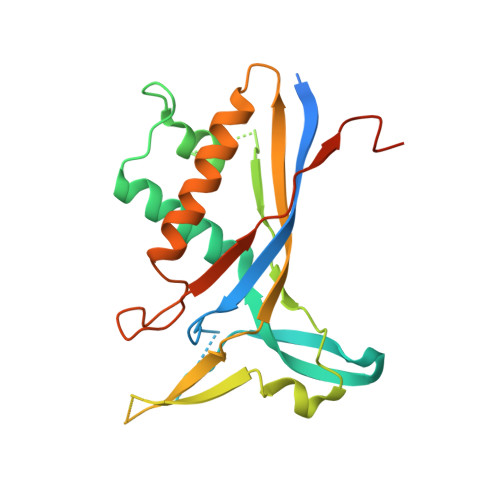Crystal Structures of Csm2 and Csm3 in the Type III-A CRISPR-Cas Effector Complex.
Takeshita, D., Sato, M., Inanaga, H., Numata, T.(2019) J Mol Biol 431: 748-763
- PubMed: 30639408
- DOI: https://doi.org/10.1016/j.jmb.2019.01.009
- Primary Citation of Related Structures:
6AE1, 6AE2 - PubMed Abstract:
Clustered regularly interspaced short palindromic repeat (CRISPR) loci and CRISPR-associated (Cas) genes encode CRISPR RNAs (crRNA) and Cas proteins, respectively, which play important roles in the adaptive immunity system (CRISPR-Cas system) in prokaryotes. The crRNA and Cas proteins form ribonucleoprotein effector complexes to capture and degrade invading genetic materials with base complementarity to the crRNA guide sequences. The Csm complex, a type III-A effector complex, comprises five Cas proteins (Csm1-Csm5) and a crRNA, which co-transcriptionally degrades invading DNA and RNA. Here we report the crystal structures of the Staphylococcus epidermidis Csm2 (SeCsm2) and Thermoplasma volcanium Csm3 (TvCsm3) at 2.4- and 2.7-Å resolutions, respectively. SeCsm2 adopts a monomeric globular fold by itself, in striking contrast to the previously reported Thermotoga maritima Csm2, which adopted an extended conformation and formed a dimeric structure. We propose that the globular monomeric form is the bona fide structure of Csm2. TvCsm3 forms a filamentous structure in the crystals. The molecular arrangement of TvCsm3 is similar to that of the stacked Cmr4 proteins in the Cmr complex, suggesting the functionally relevant architecture of the present Csm3 structure. We constructed model structures of the Csm complex, which revealed that Csm3 binds the crRNA and periodically deforms the crRNA-target duplex by a similar mechanism to that of Cmr4 in the Cmr complex. The model and mutational analysis suggest that the conserved lysine residue of Csm2 is important for target RNA binding, and Csm2 stabilizes the active structure of the Csm complex to facilitate the reaction.
Organizational Affiliation:
Biomedical Research Institute, National Institute of Advanced Industrial Science and Technology (AIST), 1-1-1 Higashi, Tsukuba-shi, Ibaraki 305-8566, Japan.














